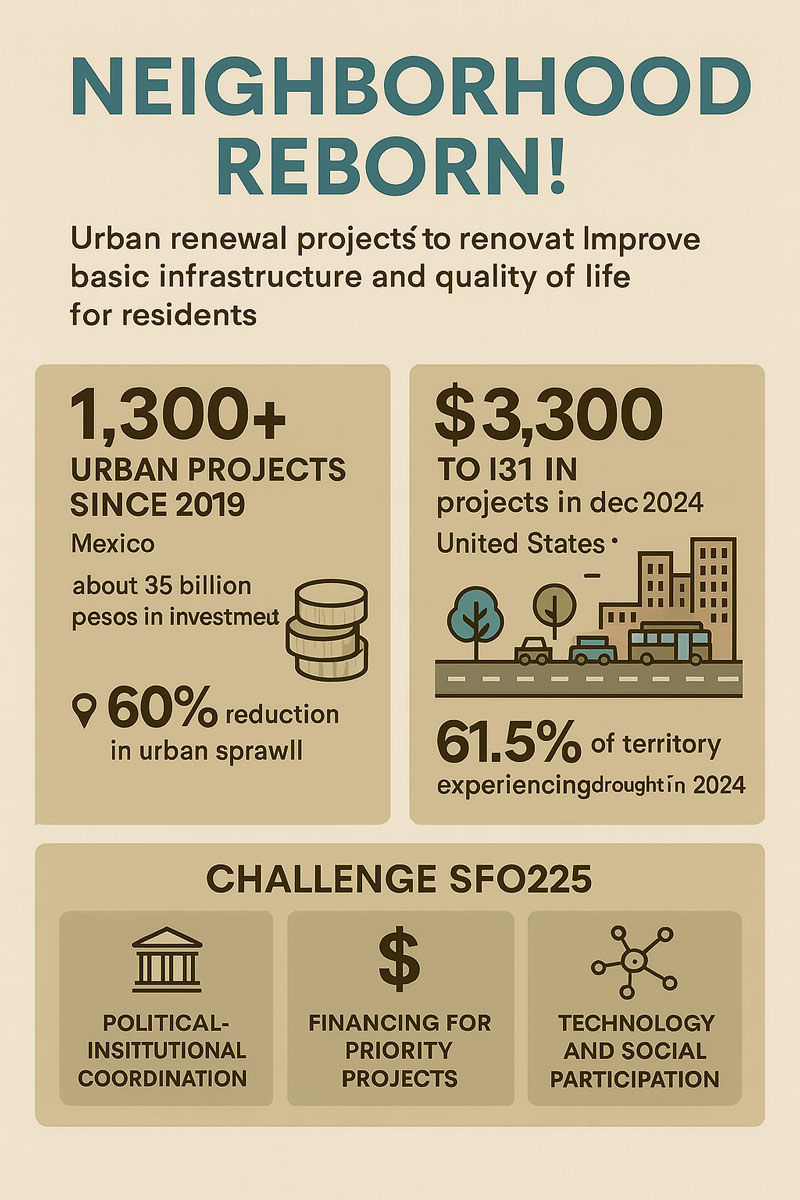Neighborhoods Reborn! The revolution of urban renewal in Mexico and the U.S.
- Editorial

- Sep 18
- 3 min read

The renewal of infrastructure in aging neighborhoods has ceased to be a mere aesthetic upgrade and is now a strategic necessity for competitiveness, public health, and social cohesion on both sides of the border. In 2024, Mexico and the United States accelerated projects that combine hard infrastructure, spatial justice, and civic technologies to reconnect communities, reduce service gaps, and spark local economies. In Mexico, the Secretariat of Agrarian, Territorial, and Urban Development (Sedatu) reported more than 1,300 urban works since 2019 with an investment close to 35 billion pesos, as well as 300 planning instruments. The agency asserts that these tools helped reduce urban sprawl by 60%, signaling a shift toward planning based on proximity.
These achievements unfold under unprecedented water stress. By January 15, 2024, 61.5% of Mexican territory suffered drought conditions, with 1,613 municipalities facing severe, extreme, or exceptional shortages. This makes the modernization of water and sewage networks, wells, and treatment plants a top priority. In Mexico City, experts estimated that nearly 40% of the water supply is lost to leaks from aging pipes, a stark indicator of the urgency to invest in line replacement and leakage control through sensors and active pressure management.
In the United States, 2024 marked a turning point for projects that mend the scars of urban highways and rail lines that divided neighborhoods for decades. The Department of Transportation announced in March 2024 the allocation of $3.3 billion to 131 projects across 41 states and D.C. through the Reconnecting Communities & Neighborhoods program. Iconic cases include “The Stitch” in Atlanta, a 14-acre park designed to cover a freeway and rejoin historically segregated communities. In parallel, the federal infrastructure agenda reported over $568 billion announced for more than 66,000 projects—critical mass already reaching neighborhood streets, walkability, stormwater drainage, and active transportation.
Public health has become an urban policy. In May 2024, the Environmental Protection Agency (EPA) released year-three allocations to replace lead service lines, part of a total $15 billion fund under the Bipartisan Infrastructure Law. This stands against a national need estimated between $50 and $80 billion. Cities like Milwaukee and Detroit received resources to replace thousands of pipes in 2024, with goals of full elimination within a decade. Although a journalistic audit reminded the public in 2024 that the initial distribution suffered from flawed state-level data, the EPA’s methodological adjustment that same year illustrates the importance of governance grounded in evidence.

Percentages only matter when they impact daily life. In 2024, Mexico consolidated a portfolio of proximity-based public works—parks, community centers, neighborhood streets, and markets—that, combined with planning instruments, began to correct the imbalance between sprawling peripheries and insufficient services. Still, the figures on drought and water loss underline that basic infrastructure remains the bottleneck of urban well-being. In the U.S., 2024 accelerated the repair of the physical and social fabric: billions aligned to territorial equity, projects designed to “stitch” together divided neighborhoods, and an unprecedented public health push for water networks—all under federal timelines and metrics that allow public monitoring.

Looking ahead to 2025, three challenges will determine whether this wave of urban renewal fulfills its promise. The first is political and institutional: coordination across levels of government and continuity beyond electoral cycles. Mexico must safeguard local budgets for maintenance and water—not just new construction—and deepen municipal professionalization in asset management. In the U.S., implementation will need to maintain environmental justice criteria and improve data quality after the lessons of 2024. The second is economic: closing the gap between needs and available financing. The $15 billion federal fund for lead replacement is a step forward but only covers a fraction of the estimated cost. In Mexico, the effort of more than 1,300 projects must scale through transparent public-private partnerships, land value capture, and green/blue bonds for water and sewage. The third is technological and social: deploying digital twins, sensors, and predictive analytics for water networks, pavements, and lighting while shielding communities from displacement through affordable housing policies and community participation from the design phase. Encouragingly, the 2025 pipeline is already in motion: in January, an additional $544.6 million was announced for reconnecting communities, a sign that the wave of projects will not stop.
Today, the symbolic border is not a wall but the distance between a neighborhood left behind and one renewed with resilient services, humane mobility, and open data. If 2024 was the year of unlocking resources and showing that percentages can indeed change realities, 2025 must be the year of fine-tuned execution: fewer water outages, fewer potholes, more shade, and more walkable kilometers measured with transparency. That is the true meaning of urban rebirth.
Written by: Editorial




Comments